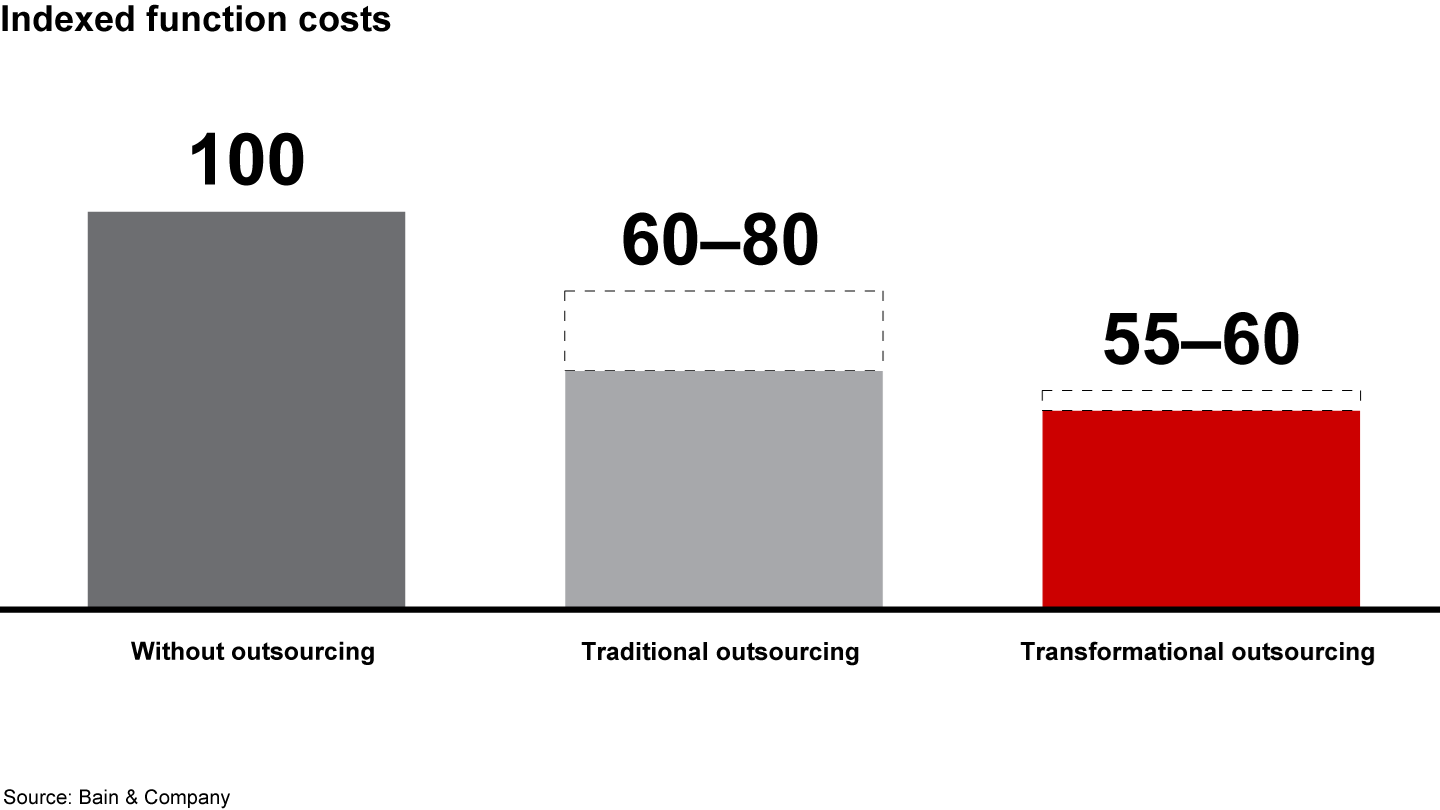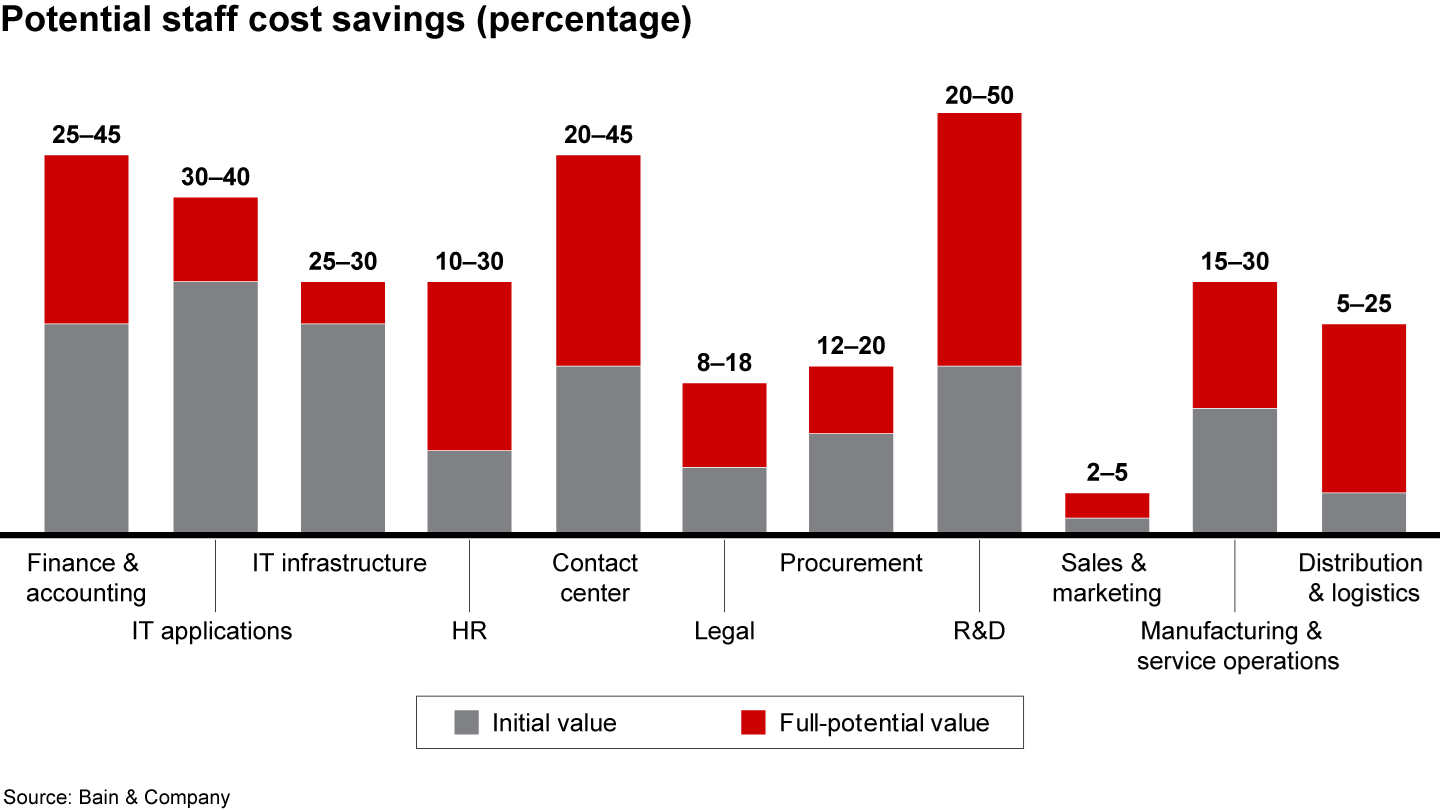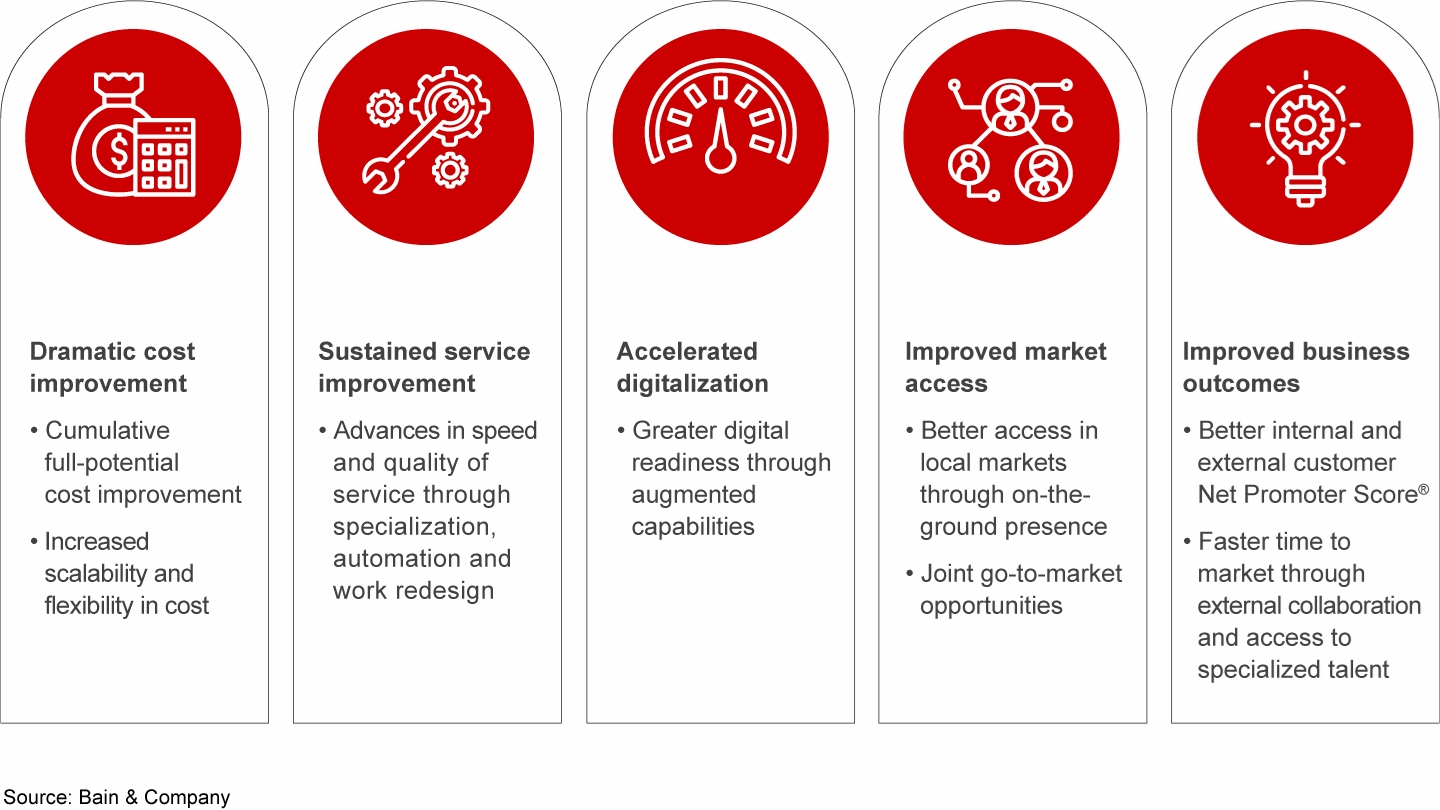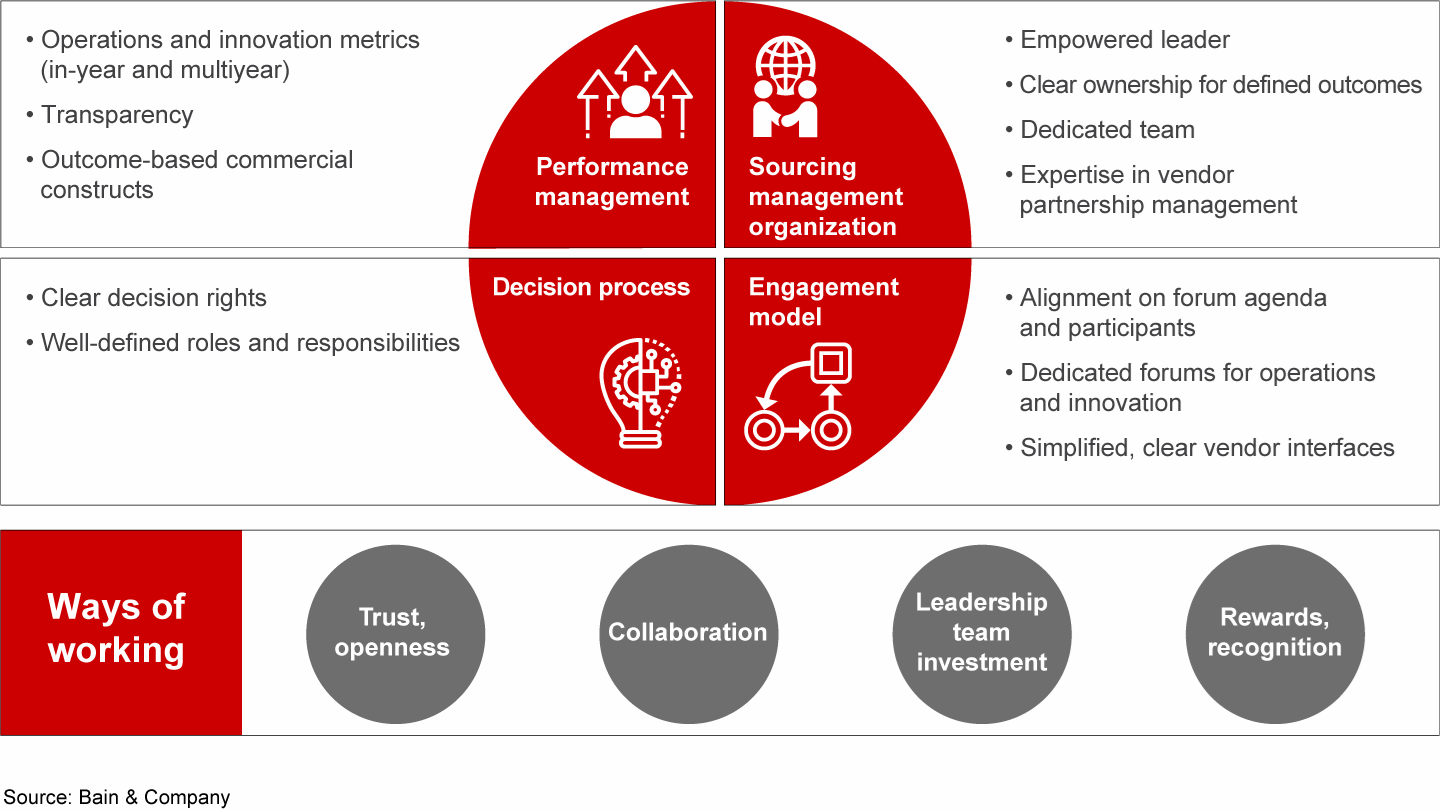Brief

Резюме
- Many firms have not fully realized the promise of outsourcing to spur step-change improvements in cost and performance.
- Outsourcing underdelivers when relationships focus on short-term tactical goals rather than on building a true partnership to tackle larger business outcomes.
- Sourcing leaders have regeared their programs to emphasize design for the longer term, joint solutions with vendors, insight-led pricing negotiations and metrics that align with business goals.
- The leaders are realizing additional cost reductions of up to 25%, as well as consistent improvements in performance and customer advocacy.
Outsourcing first proved its worth as a cost-cutting measure, primarily through labor arbitrage. Companies then used outsourcing to gain more flexibility and, in recent years, to strengthen their capabilities. Now they increasingly look for third-party vendors to advance innovative techniques that improve both cost and performance, including adoption of new digital technologies to enhance the customer experience.
Yet, even after years of experience, many firms still haven’t fully realized the promise of outsourcing. The cost benefits have not been as impressive as they anticipated, and service levels have remained largely the same despite being handed over to specialists. We commonly hear executives lament that the primary reason for subpar performance is insufficient investment in their internal capabilities to build strong vendor relationships and derive the full potential from outsourcing.
A few companies, however, are learning how to turn outsourcing into a stealth weapon, achieving outsize cost and performance improvements. For example, a US-based healthcare provider worked with its vendor on focused automation in the service desk, including automated ticket assignment and routing, password reset automation, and an internal analytics tool to figure out the root causes of the most severe recurring issues. As a result, the company dramatically reduced service ticket volumes and improved service outcomes. The cost and performance benefits were significantly greater than in traditional outsourcing, where benefits result from arbitrage and basic automation. Similarly, at an international bank, the vendor that had been running applications for nearly a decade started to embed analytics teams within the bank, in order to seek out cost improvement opportunities proactively–again, exceeding the anticipated benefits.
Transformational outsourcing delivers up to 25% improvement in functional total cost of ownership, over and above the benefits from traditional sourcing (see Figures 1 and 2). These improvements result from process redesign, digitalization and automation over the course of an outsourcing engagement.
A total cost of ownership approach to outsourcing yields substantial improvements


The cost-saving potential of effective outsourcing varies by function


In addition, companies have adopted more flexible pricing models, where cost depends on consumption and outcomes—thereby turning fixed costs into variable costs and, more important, sharing accountability with vendors for a defined set of operational and business outcomes. At one health insurer, operations outsourcing vendors signed up to spur improvements not only in operational metrics but also in customer and provider Net Promoter Score®, a key measure of loyalty. Performance improved through work redesign, automation and other technology interventions. The best outsourcers also realize ongoing cost and performance improvements through closer relationships with vendors, enabling them to introduce new techniques and ferret out new opportunities (see Figure 3).
Transformational sourcing creates value for the business well beyond cost savings


Why outsourcing falters
As we look across industries and regions, four common problems hinder sourcing programs from achieving their full potential.
The sourcing function doesn’t align closely with business objectives. With the rise of e-commerce, the infusion of digital channels into the customer experience and the onset of machine learning, business functions are trying to increase their flexibility and digital readiness, while also releasing costs that can be plowed back into investments in the experience. Sourcing programs need to adapt to these demands, but most programs and vendor relationships still tend to operate one step removed from the business.
For example, at one global electric utility, the CIO’s sourcing management team continued to push vendors for incremental cost and performance improvements, but the business’s critical technology objective (an applications overhaul to attain greater flexibility and digital readiness) was largely absent from dialogues with the vendors. By contrast, another firm insisted on aggressive automation levels during deal renewal, which would deliver a significant share of the CEO’s cost improvement mandate.
Megha Chawla, a partner with Bain's Performance Improvement practice, discusses the obstacles that some companies face with outsourcing and how they can overcome them.
All too often, large, multiunit companies run federated sourcing programs with vendors operating in silos, without a clearly defined set of sourcing objectives calibrated to the business units and communicated throughout the sourcing organization. Stated objectives often address short-term goals, such as tactical technology edits, instead of long-term business imperatives. Contracts managed through traditional service-level agreements (SLAs) neither accurately reflect the user experience nor solve for evolving requirements. Moreover, many sourcing organizations are so enmeshed in daily vendor management that they don’t take the time to aggregate feedback from the business units and translate it into an effective transformation agenda for the executive responsible for outsourcing. The business units become frustrated and lose their trust in the sourcing function.
Sourcing processes and expectations don’t encourage innovation. Organizations may expect their vendors to introduce automation, advanced analytics and other methods that foster innovation, but they typically underestimate the behavioral changes required to do so. Most existing sourcing processes have been tuned to deliver steady, reliable improvements in execution, rather than to take on an innovation agenda.
Regearing a sourcing program to foster innovation involves deliberate adjustments to design and scoping, vendor selection, pricing and risk-reward models. For example, while requests for proposals (RFPs) often mention innovation objectives, the sourcing process often focuses disproportionately on immediate, onetime cost objectives, with innovation as an afterthought. Further, during the course of the engagement, companies may hesitate to open up their systems and data to vendors, limiting the vendors’ ability to develop material innovations.
Vendor relationships get stuck in a transactional mode. Pricing constructs tend to focus disproportionately on risk vs. rewards, and they are designed to ensure basic service levels across hundreds of operational SLAs. Typically, though, they don’t attempt to promote desirable behaviors such as sustained cost improvements, innovation and inter-vendor collaboration. As a result, sourcing relationships can devolve into highly transactional affairs. Governance discussions risk becoming reviews and sales discussions rather than brainstorms on innovative solutions.
Risk-reward models can strike a balance between ensuring everyday operational reliability and fostering longer-term improvement. For instance, in addition to assessing penalties for not meeting target SLAs, companies can reward vendors for going above and beyond. Rewards might come in the form of value sharing for a vendor that innovates to reduce costs above contractual requirements, or in the form of points that accumulate to improve a vendor’s score as it bids for new business.
Pricing negotiations focus excessively on base price. While shifting accountability to the outsourcing partner is desirable, companies often make the mistake of providing insufficient visibility and data to vendors. And in trying to secure a good price, companies may not insist on getting sufficient visibility into the outsourced operation. It becomes difficult to negotiate a pricing structure favorable to each side, or to broaden the scope when bidding is noncompetitive. Negotiations end up being brute-force rate-reduction battles rather than creative discussions about joint solutions that are, by design, leaner and geared for better performance. Often, the situation is compounded by the limited data and visibility provided to the vendors by customers. This leads to downstream issues as vendors cut back on management investment and quality, in order to maintain their margins. Further, change requests become a convenient way for vendors to compensate for an unprofitable contract, making flexibility even more expensive for customers and contributing to greater resentment in the outsourcing organization. Building in more transparency vis-à-vis scope, consumption, pricing and performance, through both the vendor selection and engagement processes, and making a clean-sheet evaluation of the sourcing solution and the total cost of ownership are essential for realizing step changes in cost and performance.
The main opportunity to push for greater innovation and draw on specialist capabilities comes at contract time, and there is good news here. To keep up with rapidly changing technology requirements, corporate buyers have been trimming the sourcing cycle. The average contract length for IT and business process outsourcing (BPO) deals shrunk from about 4.8 years in 2007 to about 4.3 years in 2017, according to IDC, and we expect it will settle at slightly more than 4 years. As these shorter deals renew and companies look to tap a wider ecosystem of partners, companies and their vendors can change the nature of the relationship.
Six principles to maximize sourcing value
Sourcing leaders have started to reboot their programs by following six principles.
- Design for the future state. Among the most advanced companies, the CIO, functional heads and sourcing executives actively define the future technology and service requirements for the business and design the sourcing program accordingly, rather than focusing only on immediate cost improvements. To sharpen their view of the future, they engage closely with current and potential vendors on issues such as technology trends, best practices among other customers, upcoming priorities, and internal challenges and opportunities. They also inject future requirements into RFPs, vendor selection and ongoing governance.
- Revisit the vendor partnership strategy. Given the proliferation of vendors and increasing complexity of the vendor ecosystem, leading outsourcers are redefining their partner strategy to ensure the appropriate balance of scale, capabilities and competition between vendors. This involves developing an end-to-end view of the supplier base and spending, scope of services, geographic scope, sourcing objectives and maturity of supplier management capabilities. The point is to keep vendor partners invested in the business. While that may sound obvious, organizational complexities and bureaucracy often inhibit the translation of good intent to desired partner behaviors, access to the best capabilities and the ability to reap maximum value from vendors.
One global services organization, for instance, found itself dealing with a web of more than 30 IT services vendors, including several with a subscale presence, and redundant services provided by multiple partners. Internal buyers had widely varying levels of satisfaction with the same services. To sort out this mess, the company reorganized spending into a simple framework that determined the partner mix and panel based on the size, importance and complexity of capabilities needed.
- Cocreate rather than dictate. Deriving full-potential value from sourcing requires close collaboration and openness between vendors and customers. When companies are highly prescriptive, or hesitate to share information on internal data and systems, they constrain vendors from innovating. A BPO vendor struggled to find the right talent to meet a company’s specific demands for experience, skills and qualifications. By contrast, when the company and vendor collaborated on upgrading the skills of in-house employees, thereby relaxing some of the specifications, they got much better results. In another case, where a company clearly defined outcome goals for its contact center and shared the relevant internal information, vendors came forward with unique methodologies and tools to reimagine the solution; they took ownership not only for delivery but also for related cost and business outcomes.
- Focus on metrics that really matter. The SLA monthly dashboard may be flashing largely green, but executives might still be disappointed with the quality of service and, more important, the quality of the partnership. Poor metrics often are the culprit: too few user experience metrics; a lack of hard metrics to measure performance on innovation; too many exceptions in the contract, which undermines a risk-reward program; or limited incentives to improve performance above the base targets.
Successful SLA design homes in on what matters most to the business and which metrics best gauge those goals. The utility mentioned earlier had identified poor service quality for internal customers as a major issue, yet all of the SLA metrics delivered by the vendor were green. Further, the utility had not evaluated its issue prioritization in over a decade. The company decided to redefine metrics and prioritize them so that they would more accurately measure the end-user experience. While it continued to publish traditional SLA metrics, the company would also require vendors to publish a few key end-user metrics and, at the same time, drop some largely operational metrics that conveyed little information about the user experience.
Once the right metrics have surfaced, risk-reward mechanisms should align with them. That can be as simple as indexing the SLA regimen service availability as opposed to ticket resolution time, though in some cases it requires deeper analytics to understand the correlation between SLA performance and end-user satisfaction. As for objectives that foster innovation, greater automation, and use of predictive analytics and Big Data-informed operations, the corresponding metrics should track vendor performance along those lines, such as tickets automated each year. Companies can complement these metrics with a risk-reward framework that incents vendors to come forward with new ideas.
- Price to motivate both parties. If companies focus disproportionately on billing rates during vendor selection, they wind up squeezing the vendor’s profit margins, which can lead the vendor to cut corners to make itself whole. Some vendors minimize account-related spending to improve profitability, causing a decline in service quality and almost no focus on innovation.
During negotiations, outsourcers must provide sufficient and timely data so that the vendor can effectively price its services as well as understand the drivers of cost. That way, negotiations can focus on solutions, not just the billing rate. At one firm, the CIO determined it would be more effective to collaborate with the provider on improving productivity in average handling time rather than asking to reduce the billing rate per person. Likewise, as part of a finance group transformation, a managed services firm was more confident negotiating the location of the service provided than the billing rate per person. In each case, the companies aimed to achieve a better total cost of ownership without squeezing the profit margins of their vendors.
World-class outsourcers that use such methods have managed to achieve up to 25% additional improvement in total functional costs, in our experience, while also ensuring trust and transparency in commercial negotiations, setting the tone for a durable partnership.
- Overinvest in sourcing management capabilities to ensure that ways of working change. The team working directly with providers will make or break sourcing partnerships. Too often, firms invest heavily in vendor selection and transition but underinvest in sourcing management. Sustaining high performance throughout the engagement requires a robust management capability, with thoughtful design of the governance organization and vendor interactions. Gaps in engagement most commonly occur at the executive level. Effective sourcing organizations stand up a small, high-performing management team that takes accountability for a clear set of tasks, decisions and outcomes (see Figure 4). They recognize that they are change agents who benefit from getting all the stakeholders aligned on the intent and guiding principles of the program from the beginning. Further, they recognize that it takes two to tango. That means investing time in the relationship, through governance forums, rewards and recognition for the outsourced staff.
A world-class sourcing management system consists of several components


As companies pursue higher performance, sustained cost improvement and innovation along several fronts, they will undoubtedly benefit from the specialized knowledge and skills of service providers. This is especially helpful when organizations want to catalyze changes in how functions operate. Many providers have wide expertise across industries that allows them to broaden the art of the possible. Most innovation flows from the right team assembled in doing the right tasks—and outsourced vendors will play an increasingly prominent role for the companies that learn how to shape a fruitful partnership.
Bhanu Singh and Megha Chawla are partners with Bain & Company's Technology and Performance Improvement practices, based in New Delhi. Bhanu leads the firm's capability sourcing work globally, and Megha leads it in India. Samyukktha T is a manager with Bain's Technology practice.